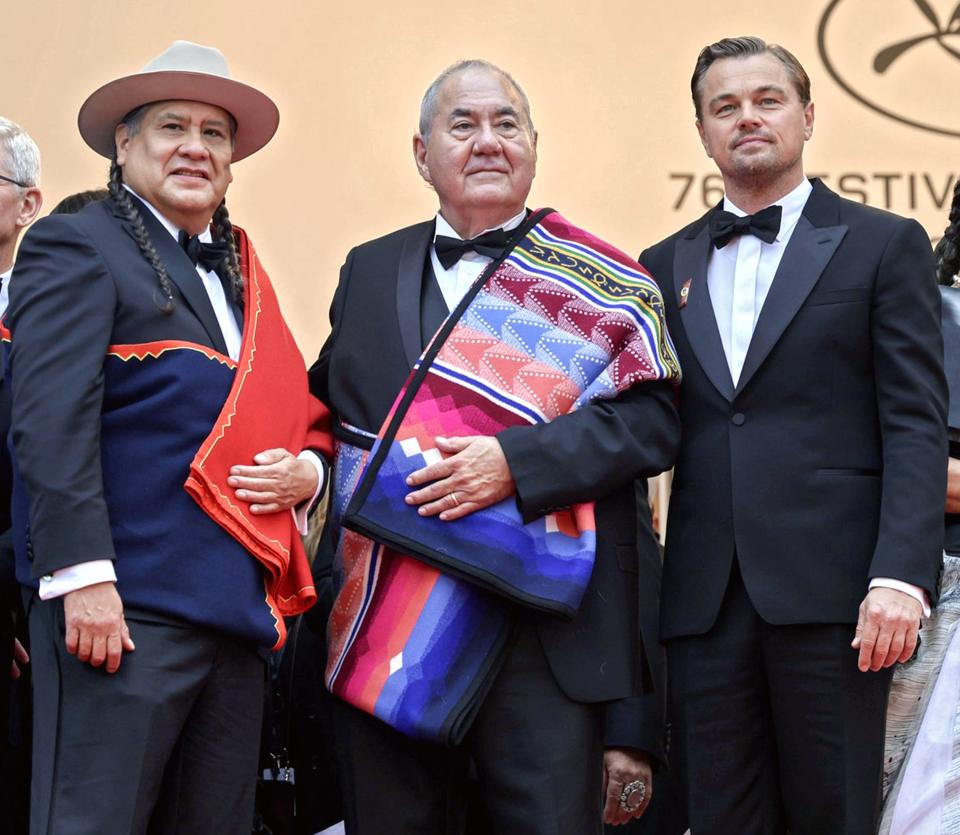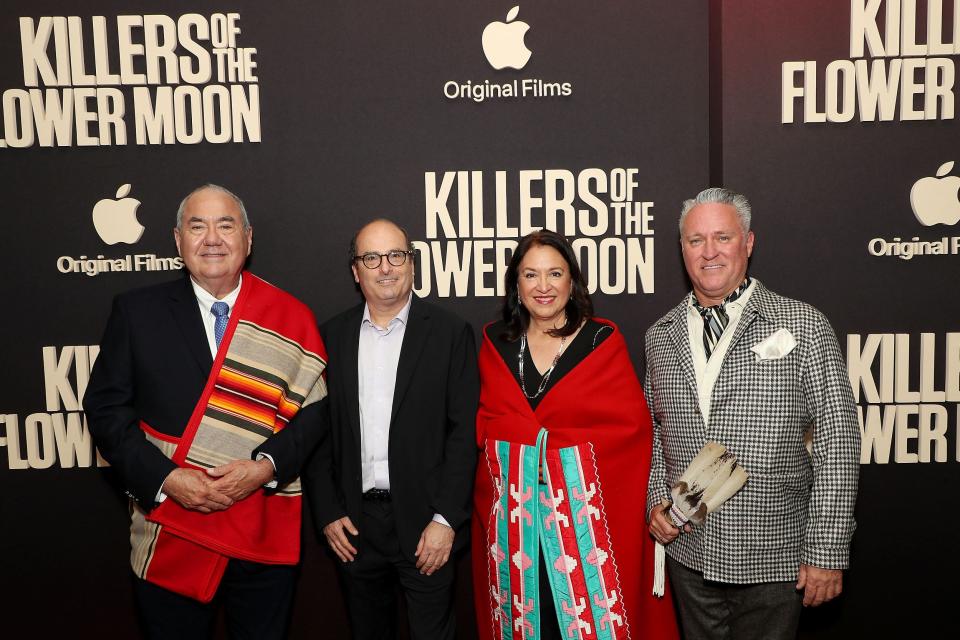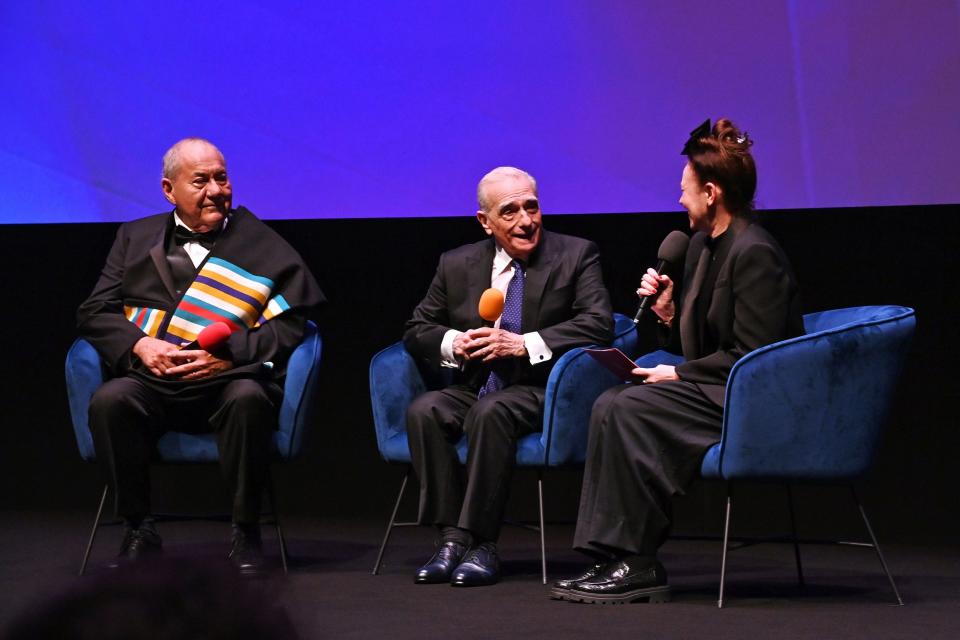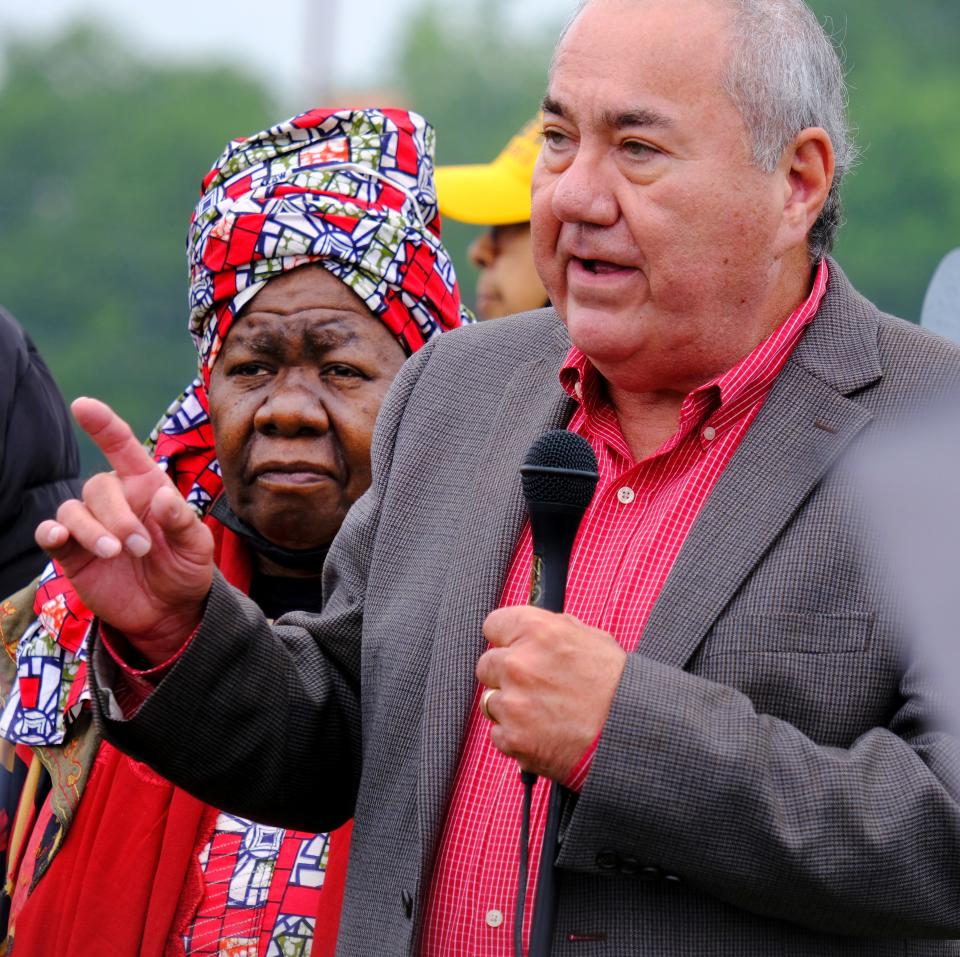'It's authentic': Osage Nation Chief Standing Bear praises film 'Killers of the Flower Moon'
For his first red-carpet experience, Geoffrey Standing Bear found himself at the prestigious Cannes Film Festival promoting the latest $200 million cinematic epic from legendary moviemaker Martin Scorsese.
"I just wanted to make sure I walked the length of the carpet and to those imposing stairs. I didn't even get concerned about the cameras. They were there, but fortunately, as I got closer to the stairs, everybody started looking behind me because the actors started coming forward,” Standing Bear told The Oklahoman.
"It was just like an out-of-body experience really."

Since attending the May 20 world premiere of "Killers of the Flower Moon" in France, the Osage Nation's principal chief has hit the red carpet several more times leading up to the eagerly awaited film's Oct. 20 global theatrical debut. Already this month, Standing Bear has supported the movie at the BFI London Film Festival and at premieres in New York City and Mexico City.
"People don't realize — I didn't — how hard they worked to put this movie together, and the studying they did. The emotion you see from them, how they craft that, it was so impressive. It was just a privilege and a lifelong memory to watch great artists at work," Standing Bear said in a summer Zoom interview.
"And our people are everywhere in this movie."

Osage chief and 'Killers of the Flower Moon' author participating in Oklahoma panel
Filmed in and around the Osage Nation in northeastern Oklahoma in 2021, the anticipated film is adapted from David Grann's 2017 New York Times best-seller “Killers of the Flower Moon: The Osage Murders and the Birth of the FBI."
Like the National Book Award finalist, Scorsese's fact-based Western chronicles a dark chapter in the tribe's history: The film relates the serial murders of Osage Nation citizens in 1920s Oklahoma, after an oil boom made them the wealthiest people in the world per capita. The killings became known as the "Reign of Terror" and led to an investigation by the then-fledgling FBI.

"I came for a few days and actually brought my family, and it was pretty remarkable to see the set. I'd never seen a set like that before. Just to see a scene on the street with so many extras and the recreation of the town with such authenticity and accuracy," Grann told The Oklahoman in a 2021 interview.
"Perhaps the thing that just for me was so exciting and gratifying was to see that level of Osage involvement."
Grann, Standing Bear, Chickasaw Nation Gov. Bill Anoatubby and FBI Special Agent Edward Gray are participating in a free public "Killers of the Flower Moon" panel discussion at 4 p.m. Oct. 17 at Oklahoma Christian University's Garvey Center. It will be followed by a lecture by Grann at 7 p.m. Oct. 17 at the Edmond university.
Ahead of the panel, lecture and film's theatrical bow, Standing Bear spoke with The Oklahoman about the making of and anticipated impact of the movie:
Q: What has it been like to have ‘Killers of the Flower Moon’ reveal this tragic Osage history?
Standing Bear: This story's been told before. But David earned the trust of the Osage, by the way he approached his interviews, the research he did and talking to the descendants of the murdered people. And that respect is something that carried over into the producers, into the actors, all the way through the screenings. ... That book really gives you the historical background and a lot of the inside documented information.
But when you get to the movie, you'll see where Martin Scorsese and his team have ... moved away from the FBI story in favor of a more in-depth view about Mollie, the Osage woman (played by Native American actress Lily Gladstone), and her relationship with her husband, Ernest Burkhart, played by Leonardo DiCaprio, and his uncle William Hale, played by Robert De Niro.

Q: What reactions have Osage people who have seen the movie shared with you?
Standing Bear: I talked to several Osages after they viewed the movie a few weeks ago, and I was struck by how four different Osages of different generations who did not know each other described their feelings or their view of the movie as heavy. ... It's a lot to process, especially if you're Osage.
It is a heavy movie, and it's three and a half hours long. But it doesn't seem like three and a half hours. ... It’s not boring. It's just different than Scorsese's other movies.

Q: Can you talk about the Osage Nation's involvement with the making of the film?
Standing Bear: It started when Imperative (Entertainment in 2016) purchased the rights from David Grann for the book. We emphasized that we needed our Osage culture and language to be told by us and not someone else — and that was the thrust of every conversation we had.
And the conversations paused during the pandemic, which later, Mr. Scorsese told me he was thinking and working on this movie every day during that pause, which may have contributed to the depth of this movie.
But we continued to make the point that it needed to be filmed here as well, because our people are not going to travel to other states — some were far away — that they were looking at for this movie. So, we opened up our programs to them, our language speakers worked very closely with the actors and directors, and did a great job. Our traditional people worked with their costume people to do these really authentic clothing and costumes.
Our culture people worked closely on some of the ceremonies that appear in the movie. You just go down the line, and I can speak for all of us saying that it's authentic. … We're real proud of everybody — the Osages and (those from) other tribes — that participated in making this movie, and not only as extras or as actors but behind the scenes.
Q: Scorsese and his team invested a lot in making this movie accurate. Do you think that shows in the final film?
Standing Bear: Yes. The first half of the movie, I'd say a large portion of it is in the Osage language — and that's how it was back then. ... Our people were living back in the '20s in their minds here (during filming). I talked to my nieces and nephews, 'What's it like?' They said, 'Well, Uncle Geoff, we have to be ready at like 6:30 in the morning, all dressed. … We do a lot of waiting, and then we go do our filming. And then, we are done in the evening, and then we go home. Some of us travel 30, 40 miles, and we take care of our families, get dinner, shower and get up the next morning.' And they did that for months. ...
When you saw the sets and the clothing — not just of the Osages, but everyone else — live down there on those dirt streets, it was incredible. ... This is one of the last of the great directors that can build that world with his team.
Q: At a press conference in Cannes, you spoke eloquently about how Scorsese's work on this film had helped heal the breach of trust between the Osage and American society. Why is that?
Scorsese: Maybe our second meeting with Marty Scorsese, I asked him, 'How are you going to approach this story? Because ... it's complicated.’ And he said to me, 'I'm going to tell this story at two levels: about the trust that developed between the Osage people and the outside world and the betrayal of that trust, but also about the trust that Mollie had in Ernest, her husband, and the betrayal of that trust. Because this is a movie about trust and betrayal.' I was so impressed with how he said that. It told me that he knows the way he's going to come at this movie, and you'll see that in the movie, that vision.
Q: With the delays on the film because of the pandemic, do you feel like now is the right time for people to see it?
Standing Bear: As I was watching the film, Scorsese had intertwined some black-and-white film from the Tulsa Race Massacre into this movie ... and I was thinking, 'That time period for people of color was just really dangerous.' And I can tell you that a lot of the Osage moved away from Oklahoma. ...
Half the Osage tribe does not live in Oklahoma right now, and part of what we've been trying to do here is to make sure that our people have a place to come back to.

Q: What do you think will be the lasting effects of this film?
Standing Bear: We're working with Lt. Gov. Pinnell and the state tourism office, trying to bring some of the economy benefits to the town of Fairfax, which has not had much economic development going for some years. It's a challenge, but we're all working together to do it.
The other major aspect, I believe, is for other tribes, that people can know your story as a tribal nation — and it can be told by you. You just got to get the right people to work with. Where before we were a Hollywood stereotype, the Native cultures are very, very different from each other. We all have some certain commonalities, but there is a lot of diversity in our ways from the tribes from one part of the state to the other, those that were lucky enough or have toughed it out enough to keep their language and culture. Ours is still in danger, as are many of the other tribes'.
But to tell your story on the big screen, I don't think it can get better than this — but it can be done.
'KILLERS OF THE FLOWER MOON' PANEL AND LECTURE
Panel: 4 p.m. Oct. 17 with author David Grann, Osage Nation Principal Chief Geoffrey Standing Bear, Chickasaw Nation Gov. Bill Anoatubby and FBI Special Agent Edward Gray.
Grann lecture: 7 p.m. Oct. 17.
Where: Oklahoma Christian University, Garvey Center, 2501 E Memorial Rd., Edmond.
Admission: Free.
Information: https://www.oc.edu/events.
This article originally appeared on Oklahoman: Osage chief praises Martin Scorsese's 'Killers of the Flower Moon'
